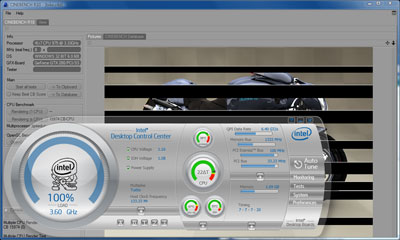Vital Signs and Overclocking


Intel Core i7 975 Extreme Edition CPU-Z Details
Here you can also see that the QPI link (Quick Path Interconnect) for the Core i7 975 Extreme Edition is 3200MHz which offers 32GB/s of serial, bi-directional bandwidth, or a total of 6.4GT/s (GigaTransfers per second), as Intel likes to quantify it. In short, that's a bucket-load of bandwidth for any processor architecture. Also there are 4 cores shown here, capable of processing 8 threads via Intel Hyperthreading technology. Finally, those cores are backed up by 32Kx4 instruction and 32Kx4 data L1 cache (32K per core), 256K of L2 cache per physical core (1MB total) and 8MB of shared L3 cache.
Beyond that, one very distinct notable is the fact that this revision of the chip is based on the Core i7's D0 stepping, which has been widely reported as having significantly more flexibility and potential in terms of overclocking. Specifically, with respect to memory speeds, this stepping of the processor can offer some pretty magical combinations of both core clock speed and DDR-3 memory speeds. As such, we set out to see what the Core i7 975 could do with a standard retail PIB cooler snapped on top to keep it stable. First, let's look at thermals...
|
Here we've got the Core i7 975 setup with a Turbo Boost clock speed of 3.6GHz and a 27X multiplier. We've also have Cinebench R10 loaded up in the background pushing a 100% load on the processor. We ran Cinebench in a loop, just to warm the core up a bit and then took this reading at full load. In our open air test bench bench setup, the Core i7 975 Extreme Edition barely breaks a sweat at 47ºC. Of course, within the confines of a PC chassis, core temps will likely scale a bit higher, but regardless, Intel's new core stepping offers plenty of thermal margin and very reasonable operating thermals.
|
We're sure you are wondering if this new top-shelf Core i7 overclocks any better than its predecessor, so we put it through a quick round of overclocking. All overclocking was performed with the Intel stock cooler and a very modest 100mv voltage bump to allow the core to scale to 1.25V should it need the extra juice.

Intel Core i7 975 Extreme Edition Overclocked to 4.1GHz

Intel Core i7 975 Extreme Edition
Overclocked to 4.1GHz - 100% Load - DDR3 1968MHz
We were able to take the Core i7 975 Extreme Edition from its stock frequency of 3.33GHz at its stock reference clock of 133MHz, up to a maximum stable overclock of 4.1GHz with a reference clock of 164MHz. As you'll note in the above screen shots, we left the multiplier at its stock 25X setting but also did allow the memory controller to scale up to 1968MHz over its DDR3 interface. This was accomplished using some rather special OCZ Blade DDR3-2133 (PC17000) memory from our friends at OCZ that we'll give you a sneak peek of next.
We topped out at these processor and memory clock speeds with full stability and were able to run several iterations of Cinebench R10, as well as a full course of our entire benchmark suite. As such, we'll include the benchmark numbers for the Core i7 975 at 4.1GHz for all of our benchmark results in the pages ahead. Again this was all performed with a stock, retail Intel heatsink. Impressive, to say the least.







